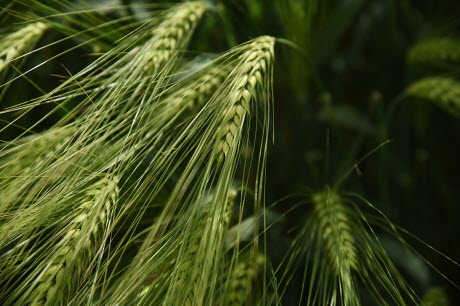Malting Barley Research Boosts New York Craft Brewing Industry
Consumer interest in small-scale craft breweries has fueled interest in getting New York farm ingredients into beers brewed in the stat
 Gary Bergstrom, professor in the Plant Pathology and Plant-Microbe Biology Section in the School of Integrative Plant Science, leads a tour of Cornell malting barley fields.Photo credit: Jenn Thomas-Murphy/Provided
Gary Bergstrom, professor in the Plant Pathology and Plant-Microbe Biology Section in the School of Integrative Plant Science, leads a tour of Cornell malting barley fields.Photo credit: Jenn Thomas-Murphy/Provided
The start of Prohibition in 1919 ended the party for more than just beer-drinkers: It also turned fallow New York’s once-thriving malt barley industry.
When legal drinking returned in 1933, growers in the more-arid western United States dominated the market for malting barley, which—along with hops, yeast and water—is used to brew beer.
Used as a flour or an animal feed, barley grain can be dead and still be nutritional, like any grain. But for malting, the grains must still be alive—at least 95 percent germinable—to drive the chain reaction that turns starch into sugar into alcohol. This is a tricky proposition in New York’s wet climate since water causes the mature grain to sprout and die before harvest.
Researchers in the College of Agriculture and Life Sciences are leading a multiyear project aimed at bringing malting barley back to New York and helping farmers take advantage of the economic opportunities offered by the crop. This work is supported by the New York State Department of Agriculture and Markets and the Genesee Valley Regional Market Authority.
Consumer interest in small-scale craft breweries has fueled interest in getting New York farm ingredients into beers brewed in the state. In 2012, New York state legislators eased the path for smaller breweries to craft and sell their beers. Seeking to encourage economic development for farmers as well as brewers, the Farm Brewery Law requires “farm brewers” to use an increasing percentage of New York-grown ingredients in their beverages: 20 percent through 2018, 60 percent by 2019, and 90 percent by 2024.
“For farmers, if they have to sell their crop for animal feed, it’s worth half or less what they could get in selling to a brewer,” said Gary Bergstrom, professor in the Plant Pathology and Plant-Microbe Biology Section in the School of Integrative Plant Science (SIPS). “It’s a risk management situation for farmers. Our goal is to reduce that risk significantly for growers.”
In addition to harvesting living seed, farmers also must produce a grain with between 9 and 12 percent protein, and they have to ensure that their grain contains less than one part per million of deoxynivalenol—a fungus-produced chemical known by a rather descriptive term, “vomitoxin.”
“I don’t think I need to paint a picture for you,” Bergstrom said. “That’s not something we want in our beer.”
 Malting barley.Photo credit: Jenn Thomas-Murphy/ProvidedBergstrom leads a team that works to combat “vomitoxin” and other fungus-associated problems by studying the interplay of barley varieties with disease, toxins, fungicides, and management practices. The team includes Cornell Cooperative Extension field crop specialists who advise farmers on effective crop rotation, soil fertility and other best management methods.
Malting barley.Photo credit: Jenn Thomas-Murphy/ProvidedBergstrom leads a team that works to combat “vomitoxin” and other fungus-associated problems by studying the interplay of barley varieties with disease, toxins, fungicides, and management practices. The team includes Cornell Cooperative Extension field crop specialists who advise farmers on effective crop rotation, soil fertility and other best management methods.
A team led by Mark Sorrells, professor in the Plant Breeding and Genetics Section of SIPS, pinpointed the most promising cultivars for New York’s climate. They gathered the best varieties from around the world and planted them in nurseries in five locations across the state.
This initial work helped determine which varieties could be made to work here and which to avoid. The next step is breeding and selecting genetic varieties specifically for New York. Sorrells’ program is called “Born, Bred and Brewed in New York.”
Impact
When the Cornell team began working on the problem in 2014, it surveyed commercial malting barley fields across New York state for quality of harvested grain. In 2014, grain from fewer than half of planted fields met quality standards required for purchase by malt houses; three years later, more than 70 percent of grain samples from New York fields achieved malt quality, due to improved crop management following guidance from the Cornell team.
Jeffrey Trout, fourth-generation owner of Poormon Farms in Seneca County, saw malt barley as an opportunity to diversify his farm and contribute to the rural economy. He started growing malt barley in 2012, and lauded the work of Cornell Cooperative Extension for providing training and networking opportunities.
“This industry could not move ahead as quickly or as thoroughly without Cornell’s dedicated efforts,” Trout said.
Erin Tones ’07 is marketing and logistics manager of the just-opened 1886 Malt House in Fulton—one of a dozen new malt houses opened in New York since passage of the Farm Brewery Law.
Cornell-led conferences on malting grain varieties and agronomic practices have been “key to the growers’ success, which is necessary for our success,” Tones said. “Cornell has been instrumental in getting this project off the ground.”
Krisy Gashler is a freelance writer for the College of Agriculture and Life Sciences.
